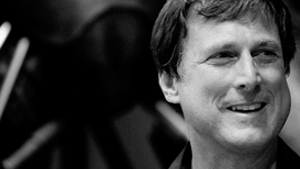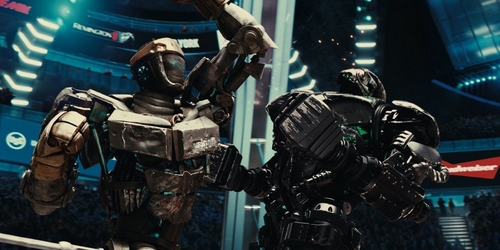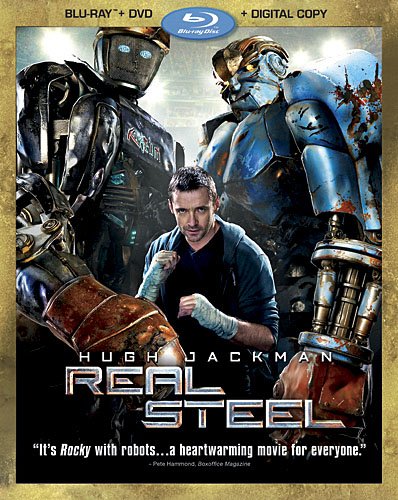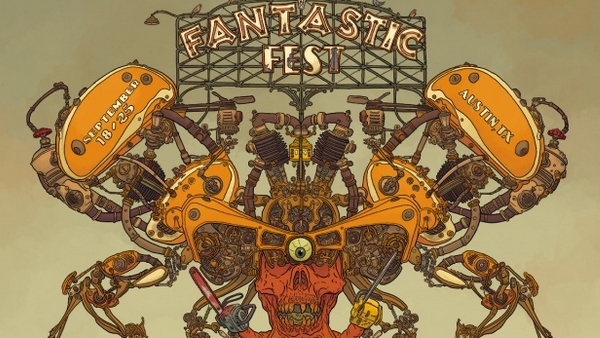 John Rosengrant has been creating groundbreaking special effects for films since working with Stan Winston on The Terminator. He did spectacularly seamless VFX work for Dreamworks’ Real Steel and his marriage of practical and CG robots really helped sell the heart of this wonderful family film.
John Rosengrant has been creating groundbreaking special effects for films since working with Stan Winston on The Terminator. He did spectacularly seamless VFX work for Dreamworks’ Real Steel and his marriage of practical and CG robots really helped sell the heart of this wonderful family film.
He’s worked on all sorts of films from sci-fi classics like The Terminator and Predator to blockbusters like Jurassic Park and Avatar (just check out his IMDb page or see his bio at the bottom of this post). Basically if there was mind-blowing movie magic happening on screen, it was most likely John working his magic off screen. Go, See, Talk and other movie sites were invited to participate in an exclusive round table discussion with this veteran of the FX world. John had lots to offer about his passion, his profession and personal tastes in his creative process.
Have a look at what he had to say…(sorry no audio but G-S-T’s questions are in Orange)
From Terminator to Avatar you seem to have been on the cutting edge of VFX work and now that we’re in an era of very prominent CGI, how do you handle the collaboration between practical and CG effects?
- John Rosengrant: I think the challenges are you want to make it seamless. Shawn Levy, the Producers, and the team over at Digital Domain lead by Erik Nash, we all went into this with a team mentality that we are going to help each other and really make it believable, even in shots where it wasn’t going to be practical and was going to be CG. The practical robot gave it great lighting and size reference. In the shots that it was practical, it also helped the performance all around by giving the actors something to react to.
How long before shooting started did you have to prepare and design the bots?
- John Rosengrant: The process took five months. Six weeks of it was designing and sculpting the robots digitally and breaking down all the pieces to be rapid prototypes. Each hero robot consisted of about 300 parts. The remaining time was the actual building of the robots.
Was there any technology you had to force into existance to make the movements work?
- John Rosengrant: As far as new technology, we used what is called our stealth control system. We developed a special hydraulic pump that was very portable and light weight and, coupled with an intuitive control system, enabled us to set the robots up for shooting in about ten minutes.
How different is to work with animatronics than to work with actors?
- John Rosengrant: The challenge with animatronics is to get a believable performance from something that is a machine. And our background, besides being artists and engineers, is that were puppeteers and performers too. So we sort of channel that energy to bring the characters to life.
Which robot was your favorite?
- John Rosengrant: They are all your babies. You put just as much time and energy into all of them. But I think Atom in this case displayed a lot of heart and soul for a robot. So I guess I lean towards Atom.
Which was the most complex sequence you had to face while making the movie?
- John Rosengrant: As with many special effects movies there are many. But one that jumps to mind is when they first power-up Atom when he is pulled from the junk yard. We had to cover the hero robot in mud, and make him sit up. There wasn’t as much prep time as one would like to have had but I think the scene turned out terrific. And I’m very proud of it.
How did you end up working into the movies and in your particular field?
- John Rosengrant: Ever since I was five years old, I wanted to make monsters. I was an art major in college but I really wanted to do this type of special effects. I moved out to California to pursue that dream and Stan Winston hired me on the first Terminator and gave me that opportunity. I worked for Stan for 25 years until his untimely passing. With my three other partners that ran Stan’s shop, we formed Legacy Effects in his honor and to carry on his legacy.
Can you explain your job as an Animatronic Supervisor?
- John Rosengrant: It’s building of the animatronic robots by sculpting, molding, engineering, selecting paint finishes, developing control systems and managing the overall performance of them on set.
What are the robots made of?
- John Rosengrant: The panels and shells are made of fiberglass and custom blend of urethane. The mechanical structure inside is a combination of steel and aluminum and there are several of the robots that are machined aluminum parts. The Heroes are a combination of hydraulically powered and rod puppeted.
Did you have to work closely with the actors too for the scenes?
- John Rosengrant: Yes, we definitely work closely with the actors. The three hero robots that we made (out of the 27 total) were the ones that Hugh Jackman and Dakota who played Max were going to interact with specifically. It was very helpful for Dakota who was 10 years old at the time to really have a functioning robot that he could perform with. I think you can see a magical spark on film that you can see between the two of them.
In your opinion, what did Stan Winston bring to the business and the art of cinema? What is the essence of his legacy?
- John Rosengrant: The essence of Stan’s legacy is that he taught me what our job is to create characters. It’s not so much special effects but more so to create a memorable character. Stan was a makeup artist and a fine artist but he originally came to Hollywood to get into acting so I think he really stressed the performance aspect. Whether it was the queen alien or the Terminator, or the dinosaurs in Jurassic Park, they always had an attitude and always seemed to be alive.
Congratulations for your fresh Academy Award Nomination! How does it feel?
- John Rosengrant: Pretty damn good! Hats off to my terrific crew and all their hard work.
How did you work to mix animatronics and CGI in Real Steel? What was the criteria to choose one instead of the other in each shot?
- John Rosengrant: The guideline was whether the Robot was really going to interact with the actors in a touchy feely way or other things such as that which would be really difficult to do in CG. For example, when Atom sits up with mud crumbling on him. The other thing was when Dakota needed to interact with Atom, when he’s in shadow mode and when he’s mirroring his moves, everyone felt that it was very important to give Dakota something to react to.
In what way did your work change since “The Terminator”?
- John Rosengrant: On this movie, we built real robots and on the first Terminator we were pretending to build real robots. Also, the state of the art technology that has allowed us to sculpt robots and their parts digitally and rapid prototype them into the real world has allowed us to do things that were never possible back then.
When you signed up for the project, did you already have a clear vision of the robots’ design? Or was it more like an developing-process?
- John Rosengrant: The design had been worked out between Shawn Levy and Tom Meyer, the production designer. What we did was take Tom and his team’s designs, sculpt all of those parts and work it out so that we had a mechanical armature that would really function and work. We added our own embellishments and flurishments but it was a great starting development from Tom.
Congratulations for the great work on ‘Real Steel’. What was the most challenging character to make?
- John Rosengrant: It was Atom. There are a lot more parts to him than others and more complicated scenes to do with him.
Did you come up with anything new for “Real Steel?” Some kind of technology or technique that hadn’t been used before?
- John Rosengrant: We improved vastly upon techniques that were used in the past. One thing in particular was what we called our stealth control system which entailed a custom made lightweight portable hydraulic pump and intuitive puppeting control system that allowed us to set up these 8 foot tall, two hundred pound robots and have them camera ready in about 10 minutes. The other innovation is our in-house pipeline that enabled us to go from digital sculpture to rapid prototyping parts in a really short amount of time and allows us to virtually preplan all of the mechanical engineering before we create anything in the real world. This helps us to avoid any sort of retrofitting and stops us from making any structural mistakes ahead of time.
What is the most exciting part of your work?
- John Rosengrant: Watching the characters we build come to life.
Who got to keep the robots after the movie?
- John Rosengrant: We keep the robots at Legacy Effects.
For a person who dreams of wanting to get into your line of work, what advice would you give them?
- John Rosengrant: You have to be artistically rounded. Nowadays that includes knowing digital art programs as well as practical, and art techniques. If youre coming at this more so from a mechanical side, you need machining skills, welding, and a sense of robots and computer control systems.
What do you think is the future of animation and animatronics?
- John Rosengrant: It has a place because we figured out on Real Steel that it provides a fantastic reference for the CG robots and gave the actors something to really play off of and react to. Good acting comes from reacting. By having something real there, the actors can connect to something.
I agree with Steven Spielberg that having robots built than CGI’d made a big impact in the film, but I’m curious, from start to finish…how long did it take Legacy Effects to create nearly two dozen robots?
- John Rosengrant: We spent a total of five months and six weeks of that five months was sculpting. The rest was actually producing them.
Steven Spielberg,Shawn Levy, Hugh Jackman, Evangeline Lilly…what do you think about working with them?
- John Rosengrant: Had the honor of working with Steven Spielberg on two of the Jurassic Park movies and the last Indie movie. It was a pleasure working with Shawn Levy, I love his creative energy. Hugh Jackman is a great actor and a true gentleman.
Who are some of your mentors and do you still refer/consult with them very often?
- John Rosengrant: My great mentor is Stan Winston who I worked for 25 years. He was a great artist, was an effects genius and, most importantly, he was a great man to know.
What film or previous experience do you think prepped you the most for Real Steel?
- John Rosengrant: I have been prepping for Real Steel since the first Terminator, lol. We’ve done our share of robots. Technically we’ve made a lot of advancements in probably the last four years that enabled us to pull this off at this level in a very short amount of time.
Do you think that animatronics and practical effects could add something that digital fx cannot give to a movie?
- John Rosengrant: In this movie, they gave something for the actors to react to besides just a tennis ball for an eyeline. It was crucial to help with their performance. Having said that, I think that the CG robots are so seamlessly done to match my animatronic robots and that is whats really successful about the visual effects in the film. Its a great mix of both CG and practical.
In the feature “Building the Bots,” director Shawn Levy talks about how Steven Spielberg emphasized that the use of practical effects was important to the film’s success. Do you feel as if filmmakers with that sort of insight into practical effects are a dying breed? Also, has Legacy Effects been approached to go back to robots for Spielberg’s upcoming “Robopocalypse?”
- John Rosengrant: Animatronic effects still have a very important place in this type of filmmaking. Some of the young filmmakers don’t have any experience with practical side of visual effects, but once they see what it can bring to their film, I think they embrace it. Spielberg’s “Roboapocalypse”, would be an amazing project to be part of.
What was it that interested you about the “Real Steel” project?
- John Rosengrant: Obviously it was a chance to create robot characters. Beyond that, and very importantly, I really like the story and the heart felt connection between the character of Max and Atom, the ‘bot’ that we helped to bring to life.
Would you say your task has been made easier with the improvements in technology?
- John Rosengrant: The technical innovations have allowed us to create at a high level and with efficient speed which was not possible in the past. The dilemma with this is everyone expects more, even quicker, each time! lol!
In 1983 you joined Stan Winston and worked in Terminator, so your experience with robots is long. What can you tell us about the challenges posed by ‘Real Steel’ for you initially?
- John Rosengrant: The amount of robots that we needed to build in a relatively short amount of time. There were a total of 27 robots which were each 8 feet tall. Three of which we hydraulically controlled and needed to perform with the actors in a believable fashion.
What is the role of animatronics in our contemporary CGI-filled movie world? What are its peculiar strengths which still hold up?
- John Rosengrant: It gives the actor something to react to that’s real and it provides a terrific reference for the CG counterpart. This helps the effects to look more real as they do not have to make up anything. The information of what the character should look like is there for them.
What’s a specific example of something you do that’s actually much harder than most people realize?
- John Rosengrant: In this movie we created 27, 8 foot tall robots. Some hero, stunt and background. But there were literally thousands of parts that had to all fit together and look like real metal and had to perform like a real robot. Noisyboy for example, had nearly 2,000 LED lights alone that were programmed with random sayings in Japanese which appeared on his forearm. That’s an example of one small complicated thing that may go unnoticed when you watch the film.
Is there any fun trivia that happened on set you can tell us about?
- John Rosengrant: All of the LED lights used in the Atom animatronic were surplus LED’s from a car manufacturer in Detroit. We filmed Real Steel in Detroit so they made their way back home.
With what software tools do you work at Legacy? How is your pipeline set up?
- John Rosengrant: We do a lot of work with Z Brush, Maya, and a program called Magics which is all part of our main pipeline.
You have worked on Iron Man, all Jurassic Parks, the Terminator-Series – can you describe what improvements have been realized through the time until your recent work on Real Steel? Have the mechanics or the hydraulics gotten more faster as a result of a faster filmmaking?
- John Rosengrant: Some of the big improvements have been the digital programs we work with to sculpt and create, in this case robots. It allows us to completely visualize what each and every part will look like and we can preview how the mechanical structure will work within the robot, as we can pre- plan and make sure all of those parts already fit within the structure properly. We can test for movement to see if any of the body shells would crash and this avoids any retro fitting or wasted time in the assembly process later. There are more materials at our disposal that are strong and light weight that we have customized to get to the exact properties we need and we’ve really perfected ways of simulating metallic finishes on plastic parts. On this film in particular, we came up with a light weight, very portable hydraulic pump that allowed us to set up very quickly on set. Today’s filmaking moves very fast and no one has time to wait to set up or fork lift in a huge hydraulic pump and hoses that take hours to set up. We had to be camera ready in about 10 minutes.
Do you have any possibility to alter and/or suggest different aesthetics / changes in art direction of the animatronics?
- John Rosengrant: In the case of Real Steel the characters were developed in collaboration between Shawn Levy, the Director and Tom Meyer the production designer. It was our job to bring them to life. They were very open to our suggestions and tweaks but all of us wanted to preserve what had been created. On a lot of films, we also design these creatures and/or characters, so we’ve had a ton of input from the start.
You have worked on many major blockbuster films, but I’m curious…which were your favorite films to work on?
- John Rosengrant: They all are your babies. You work just as hard on the small budget ones as you do on the large budget ones. Of course, it’s extremely rewarding when the movie-going public really responds to a character that you helped create. There’s no better feeling than sitting in a movie theater that’s cheering and/or frightened for your work when they see it on screen.
Can you talk about how stars approach CGI? How was Hugh Jackman on Real Steel? Did you had any kind of support from him?
- John Rosengrant: In this case, I would say the stars like having an animatronic robot on the set as it helps them to have something to visualize when the shot is going to be CG and perform to something when the shot is real. As far as Hugh Jackman, he was terrific to work with when interacting with the animatronic robot.
How many people are involved in Atom`s creation?
- John Rosengrant: There was a couple from my team that were really imperative to brining Atom to life. Jason Matthews was the key artist in charge of Atom. Ian Joyner was the key digital sculptor that translated Tom Meyer’s production design artwork into 3D. Of course, there was a team here at Legacy of engineers, mechanics and model makers led by Dave Merritt. Mold makers, artists and painters were also involved in the total execution of Atom.
“Real Steel” is more of an intimate father-son story with a Sci-fi element to it, than it is a big blockbuster effects spectacle. Was this a part of the allure to the project for you? As other projects you’ve worked on like “Avatar” and “Terminator 2” have placed the effects in a similar situation story wise.
- John Rosengrant: I love when we can help create a character that is integral to the story. It’s first and foremost a good story that touches the audience. If we can do a great job with effects to bring that story to life, then I feel like we’ve made a great contribution. That’s the key to a great movie. All the special effects in the world wont make a good movie if there is not a good story behind them.
John, any final thoughts on Real Steel as we close out this virtual roundtable?
- John Rosengrant: It was a real pleasure to work on this film as it felt like a harmonious team effort from the start. Everybody understood their role, and everyone’s part of the film was treated with great importance. Shawn Levy, the Director, had a great energy that he brought to the film. The producers were very effects savvy. I’ve had a great history working with Producer Josh McLaglen who has worked on epic effects films from Titanic to Avatar and effects producer, Ron Ames was integral in bringing us together and organizing all of the visual effects on the film. My colleagues that I’ve been nominated with were outstanding in their contributions. My team here at Legacy worked tirelessly in creating the robots. I’d l’d like to give a special nod to my right-hand man Jason Matthews who became Atom. Last but not least, thanks to my great mentor, Stan Winston, who gave me a great opportunity in this business.
Thanks to John Rosengrant for his time as well as Dreamworks for inviting us to participate in this Round Table. For those of you wanting to know a little more about John, here’s his bio:
After majoring in fine arts at Louisiana State University, John Rosengrant relocated to Los Angeles to pursue his dream of working at a special effects studio. In 1983, John joined effects maestro Stan Winston to work on the classic sci-fi action film The Terminator, establishing relationships with some of the most important filmmakers. For over two decades, John played a pivotal role in the creation of groundbreaking effects for some of Hollywood’s biggest productions.
Following Stan’s untimely death in 2008, John, along with his esteemed colleagues Alan Scott, Shane Mahan, and Lindsay Macgowan, founded Legacy Effects, where the legendary team of artists could continue to innovate and ignite the imaginations of the industry’s brightest talent.
However, making the transition from SWS to Legacy Effects proved to be no easy task. While Shane and Lindsay were shooting overseas, and Alan was leading the blooming commercial department, John was in the midst of supervisory duties for James Cameron’s record-breaking Avatar, as well as McG’s franchise follow-up: Terminator Salvation. Yet somehow, they accomplished the move to their new space in San Fernando, CA, where the studio is thriving today.
Now that Legacy Effects has made a name for itself, John is waist-deep in a slew of exciting projects. Recently, he led a crew of more than fifty artists in the creation of all robot animatronic effects for Real Steel. Subsequently, John supervised the character designs for John Carter, Disney’s production of the Edgar Rice Burroughs adaptation, directed by Andrew Stanton and scheduled for release in 2012.
John’s talents and passion have earned him the respect of some of the world’s most legendary filmmakers, who credit him with making their experiences inspiring, rewarding, and most of all, unforgettable. As Jon Landau, producer of Avatar, explained, “We went to them exactly because they had the John Rosengrant’s of the world”.
Current work by Legacy Effects can be seen in the upcoming films, The Muppets, The Twilight Saga: Breaking Dawn, Total Recall, Marvel’s The Avengers, The Amazing Spider-Man, Neighborhood Watch, and Life of Pi.



